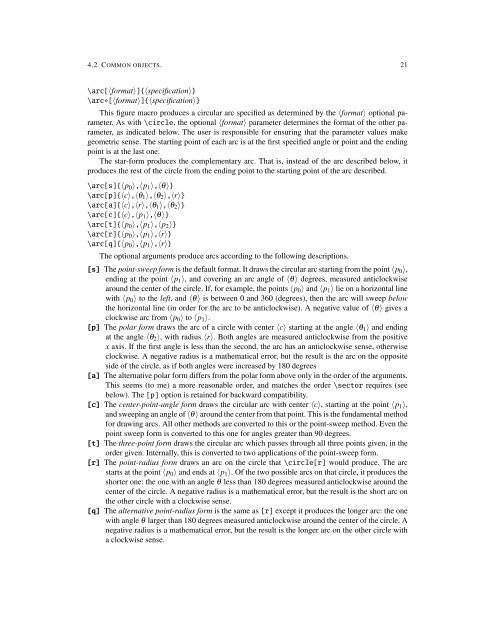You also want an ePaper? Increase the reach of your titles
YUMPU automatically turns print PDFs into web optimized ePapers that Google loves.
4.2 COMMON OBJECTS. 21<br />
\arc[〈format〉]{〈specification〉}<br />
\arc*[〈format〉]{〈specification〉}<br />
This figure macro produces a circular arc specified as determined by the 〈format〉 optional parameter.<br />
As with \circle, the optional 〈format〉 parameter determines the format of the other parameter,<br />
as indicated below. The user is responsible for ensuring that the parameter values make<br />
geometric sense. The starting point of each arc is at the first specified angle or point and the ending<br />
point is at the last one.<br />
The star-form produces the complementary arc. That is, instead of the arc described below, it<br />
produces the rest of the circle from the ending point to the starting point of the arc described.<br />
\arc[s]{〈p 0 〉,〈p 1 〉,〈θ〉}<br />
\arc[p]{〈c〉,〈θ 1 〉,〈θ 2 〉,〈r〉}<br />
\arc[a]{〈c〉,〈r〉,〈θ 1 〉,〈θ 2 〉}<br />
\arc[c]{〈c〉,〈p 1 〉,〈θ〉}<br />
\arc[t]{〈p 0 〉,〈p 1 〉,〈p 2 〉}<br />
\arc[r]{〈p 0 〉,〈p 1 〉,〈r〉}<br />
\arc[q]{〈p 0 〉,〈p 1 〉,〈r〉}<br />
The optional arguments produce arcs according to the following descriptions.<br />
[s] The point-sweep form is the default format. It draws the circular arc starting from the point 〈p 0 〉,<br />
ending at the point 〈p 1 〉, and covering an arc angle of 〈θ〉 degrees, measured anticlockwise<br />
around the center of the circle. If, for example, the points 〈p 0 〉 and 〈p 1 〉 lie on a horizontal line<br />
with 〈p 0 〉 to the left, and 〈θ〉 is between 0 and 360 (degrees), then the arc will sweep below<br />
the horizontal line (in order for the arc to be anticlockwise). A negative value of 〈θ〉 gives a<br />
clockwise arc from 〈p 0 〉 to 〈p 1 〉.<br />
[p] The polar form draws the arc of a circle with center 〈c〉 starting at the angle 〈θ 1 〉 and ending<br />
at the angle 〈θ 2 〉, with radius 〈r〉. Both angles are measured anticlockwise from the positive<br />
x axis. If the first angle is less than the second, the arc has an anticlockwise sense, otherwise<br />
clockwise. A negative radius is a mathematical error, but the result is the arc on the opposite<br />
side of the circle, as if both angles were increased by 180 degrees<br />
[a] The alternative polar form differs from the polar form above only in the order of the arguments.<br />
This seems (to me) a more reasonable order, and matches the order \sector requires (see<br />
below). The [p] option is retained for backward compatibility.<br />
[c] The center-point-angle form draws the circular arc with center 〈c〉, starting at the point 〈p 1 〉,<br />
and sweeping an angle of 〈θ〉 around the center from that point. This is the fundamental method<br />
for drawing arcs. All other methods are converted to this or the point-sweep method. Even the<br />
point sweep form is converted to this one for angles greater than 90 degrees.<br />
[t] The three-point form draws the circular arc which passes through all three points given, in the<br />
order given. Internally, this is converted to two applications of the point-sweep form.<br />
[r] The point-radius form draws an arc on the circle that \circle[r] would produce. The arc<br />
starts at the point 〈p 0 〉 and ends at 〈p 1 〉. Of the two possible arcs on that circle, it produces the<br />
shorter one: the one with an angle θ less than 180 degrees measured anticlockwise around the<br />
center of the circle. A negative radius is a mathematical error, but the result is the short arc on<br />
the other circle with a clockwise sense.<br />
[q] The alternative point-radius form is the same as [r] except it produces the longer arc: the one<br />
with angle θ larger than 180 degrees measured anticlockwise around the center of the circle. A<br />
negative radius is a mathematical error, but the result is the longer arc on the other circle with<br />
a clockwise sense.

















